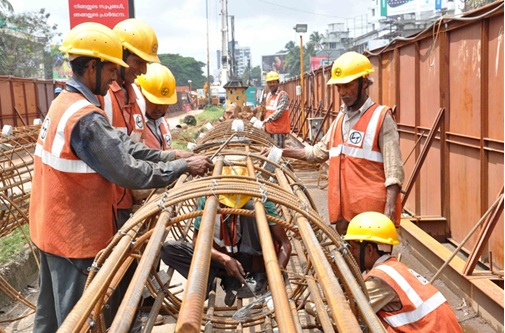(Preliminary Examination: Current Issues)
(Mains Examination, General Studies Paper 2: Topics related to the development and management of social sectors/services related to health, education, and human resources.) |
Context
A series of recent fatal industrial accidents in India have raised serious concerns about the weakening of worker safety standards and rights. These incidents have occurred, particularly in the context of changes made in the new labor codes, which have weakened labor protection measures.

Erosion of Workers' Rights in India
- India's industrial landscape is rapidly changing, but this change has come at a heavy human cost.
- Incidents such as the Sigachi Industries chemical explosion in Telangana (June 2025), the Gokulesh firecracker explosion in Sivakasi (July 2025), and the Ennore Thermal Power Station collapse in Chennai (September 2025) exemplify the declining attention to worker safety.
- According to British Safety Council data, approximately one in four fatal workplace accidents worldwide occurs in India, while this figure may be even higher due to a lack of comprehensive reporting, especially among informal and contract workers.
Causes of Industrial Accidents
- Workplace accidents in India are not unexpected, but are the result of preventable managerial negligence.
- These incidents occur due to safety deficiencies, including outdated machinery, neglected maintenance, and inadequate training of workers.
- Taking the example of the Telangana reactor explosion, equipment was operating at twice the permissible temperature, and no alarms were raised, nor was a safety officer present to intervene.
- Under these circumstances, injured workers were transported to hospitals in a broken-down company bus, demonstrating serious safety violations.
- According to the International Labour Organization (ILO), most industrial accidents are caused by cost-cutting policies and management negligence.
- Employers often attribute these incidents to human error, while the real causes are unsafe working hours, excessive workloads, low wages, and lack of rest, which force workers to work multiple shifts.
Development of Labor Protection in India
- The journey towards safe workplaces in India began with the Factories Act, 1881, which laid the foundation for regulating working conditions.
- After independence, the Factories Act, 1948, provided the basic framework for worker safety, including licensing, machinery maintenance, working hours, and facilities such as canteens and crèches.
- Following the Bhopal gas tragedy, this Act was amended in 1987, further strengthening workers' rights.
- However, enforcement of these laws was weak and compensation was often minimal, leading to employers never being held criminally liable.
New Policy Framework and Its Implications
- Since the 1990s, the era of liberalization has led to a steady decline in labor rights, justified in the name of "labor flexibility."
- Employers sought to free up their hiring and firing processes, and the government responded by weakening inspection systems and treating safety regulations as bureaucratic obstacles.
- In 2015, the Maharashtra government allowed employers to "self-certify," effectively eliminating government oversight of safety law compliance.
- The Occupational Safety, Health, and Working Conditions (OSHWC) Code, 2020, marks a major shift, as it will replace the Factories Act and transform worker protection from a legal right to executive discretion.
Widening Consequences of Weak Labor Protection
- Declining safety standards not only endanger lives but also undermine productivity and economic stability.
- According to ILO research, safe workplaces are directly linked to higher efficiency, lower absenteeism, and improved job satisfaction, but India's industrial culture prioritizes short-term profits over long-term sustainability.
- Lack of accountability has also weakened public trust.
- Trade unions and labor organizations have warned that accidents will continue until the state establishes workplace safety as a right and strengthens inspection systems.
Balancing Development and Labor Justice
- India's rapid industrialization and economic growth cannot come at the expense of workers' dignity and safety.
- The next step should be to establish labor rights as fundamental rights, not merely as a regulatory burden.
- Strengthening independent inspections, increasing penalties for safety violations, and ensuring criminal liability for negligent employers would be important steps.
- The government should expand social security coverage to include contract and gig workers, who constitute a significant portion of the workforce today.
Conclusion
Sustainable industrial development requires a social contract that values both productivity and human life. Restoring the integrity of labor protections will not only save workers' lives but also help build a just and resilient economy.



